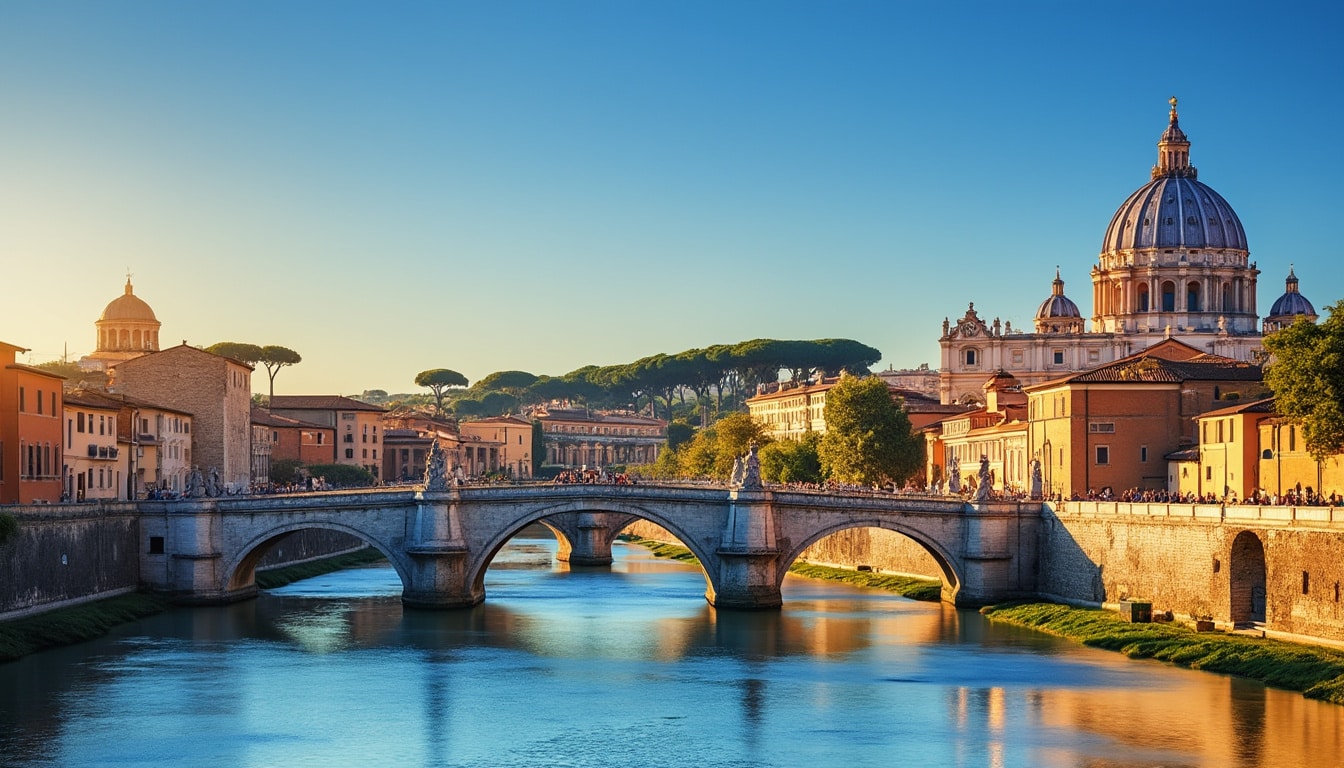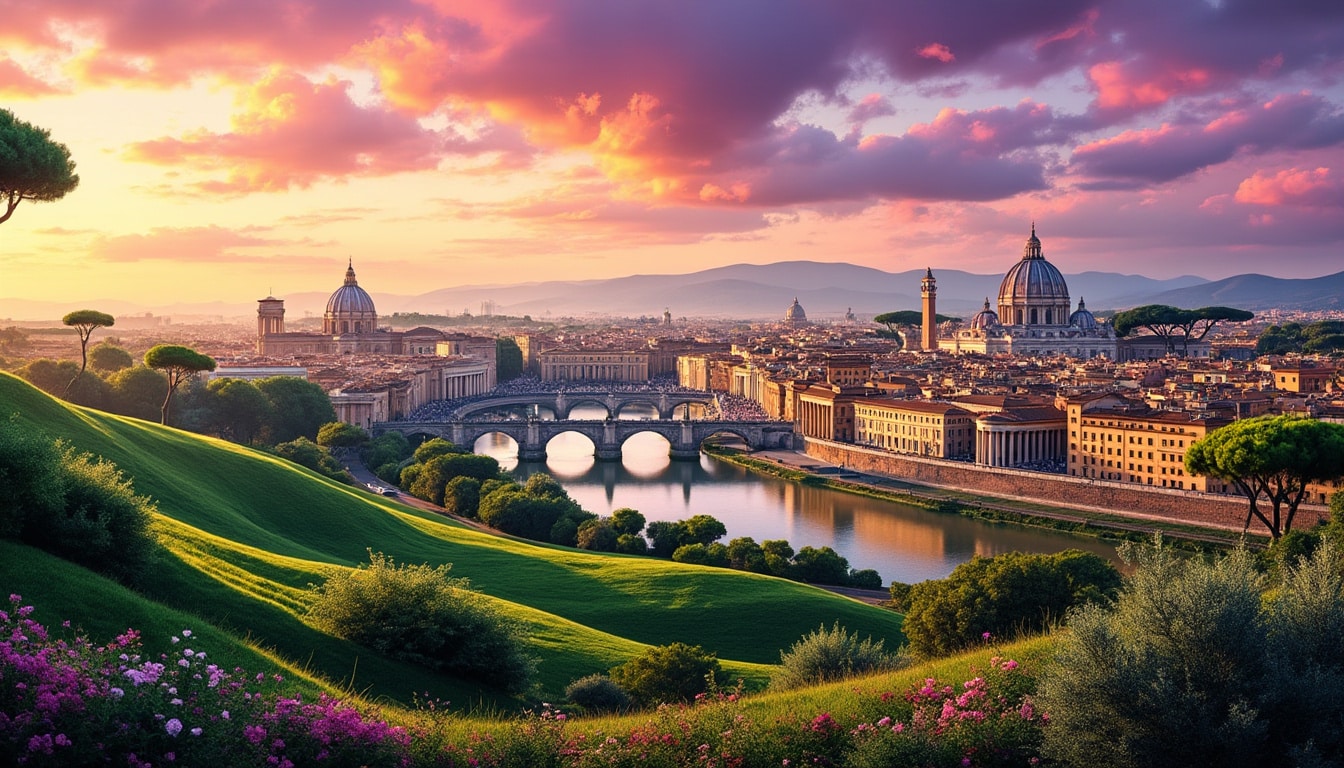Rome, the eternal city, melds history and modernity in a way few other places can. At the heart of Italy, Rome’s unique geographical positioning has not only influenced its development and survival but has also played a pivotal role in its ascension as a formidable empire. This city, with its streets whispering tales of ancient conquests and achievements, holds geographical marvels that both mesmerize and inform its visitors. From the legendary Seven Hills to the mighty Tiber River, Rome is a testament to the intricate ways geography intertwines with history. The charm of the city isn’t just in its historical landmarks but in how these geographical features continue to shape the daily lives of its inhabitants and allure globetrotters seeking unforgettable Rome Tours.
The Tiber River: Life Source of Rome
The Tiber River, known as the third-longest river in Italy, plays a crucial role in both the history and geographical features of Rome. Flowing through the city, it has provided a fertile valley that nourished early settlements and continues to be a lifeline for agriculture and commerce. Originating in the Apennine Mountains and draining into the Tyrrhenian Sea, the river serves not only as a physical landmark but also as the cradle of Roman civilization.

Historically, the Tiber River was essential for trade and defense. The river’s strategic location allowed for easy transportation of goods, ultimately contributing to the prosperity of Rome. Today, visitors can embark on delightful Tiber River Cruises that offer a unique perspective of the city’s landscape and historical sites. 🛶
The Role in Agriculture
The alluvial plains on both sides of the Tiber provided rich soil perfect for agriculture. This fertile land was conducive to the growth of vineyards, olive groves, and cereal crops, fueling Rome’s economy over centuries. Modern farming still benefits from this natural bounty, allowing the local cuisine to flourish with fresh ingredients that define Roman gastronomy.
A Natural Defense
In times of conflict, the Tiber offered a natural line of defense, deterring invaders from the south and serving as a boundary for strategic military maneuvers. By dissecting the city, the river created distinct districts with their own unique characteristics, such as the historic and culturally rich neighborhood of Trastevere.
The Tiber’s interaction with the city doesn’t stop at history. Modern concerns involve managing the river’s capacity for flooding, affecting urban planning and local life. You can learn more about flooding and natural risks in Rome to understand how the city tackles these challenges today.
With its historical significance and the sense of tranquility it imparts amid the bustling city, the Tiber River remains an emblem of Rome’s enduring legacy and natural beauty.
The Seven Hills: Foundation of Rome
The legend of Rome begins with the Seven Hills, each contributing a chapter to the city’s narrative. These hills—Aventine, Caelian, Capitoline, Esquiline, Palatine, Quirinal, and Viminal—offer more than just a picturesque landscape. They have served as the backdrop for some of the most significant developments in ancient Roman history.
The city’s beginnings on the Palatine Hill set the foundation for what would become a sprawling empire. Legend has it that Romulus and Remus, Rome’s mythical founders, had their eyes set on the Palatine Hill, the hill upon which the city was officially established.
- 🏛️ Palatine Hill: The centerpiece of Roman mythology and history.
- 🏟️ Capitoline Hill: Home to the Temple of Jupiter.
- 🌳 Aventine Hill: Known for its lush gardens and tranquil views.
- 🏘️ Esquiline Hill: A vibrant residential area with Roman villas.
- ⛲ Caelian Hill: Features ancient basilicas and religious landmarks.
- 🔭 Quirinal Hill: Presently the site of the Quirinal Palace.
- 📜 Viminal Hill: Marked by the ancient baths and literary significance.
Historical Importance
The prominence of these hills wasn’t confined to religious rites or residential settlements alone. They provided strategic advantages in military defense against invaders. Over centuries, the hills became synonymous with Rome’s power and prominence, each one symbolizing facets of public life, politics, and culture.
Walking through these hills brings history to life, offering explorers perspectives on how geography influenced the long-standing traditions and identity of Roman society. Enthusiastic visitors often partake in specialized Seven Hills Travel tours to uncover the hidden histories and archaeological wonders these hills harbor.
Modern-Day Significance
Now, these hills are among the most desirable residential areas and tourist attractions due to their elevation offering panoramic views of the cityscape. They are sanctuaries of tranquility with a touch of ancient spirit amidst the bustling city, offering opportunities for insightful hikes and leisure. The unique topography of each hill results in diverse ecosystems, adding layers of beauty to the city’s urban landscape.
Exploring the Seven Hills is like opening a portal to the past, where every ruin and remnant offers pieces of tales waiting to be discovered.
Rome’s Mountain Ranges: The Natural Barriers
The geographical dominion of Rome extends beyond hills and rivers — its mountain ranges have played a formidable role, effectively securing the domain. The Alps to the north and the Apennine Mountains running the length of the Italian peninsula have ensured Rome’s protection while influencing its climate.
These towering ranges served as natural fortifications. The Alps, with their forbidding peaks and frosty barriers, kept northern incursions at bay. On the other hand, the Apennine Mountains provided a formidable natural shield against eastern threats, fostering internal security and stability.
Climate and Agriculture
The geographical positioning of these mountains significantly influences the climate in Rome, resulting in a Mediterranean atmosphere ideal for specific crops. The rain shadow effect presented by these ranges contributes to the dry summer and mild winter conditions, perfect for cultivating the famed Roman wines and olives.
The soil’s volcanic origin has further enriched it with essential minerals, making agricultural endeavors highly successful. For centuries, these conditions have perfected the art of wine making that continues to thrive in modern Rome.
To understand how this geography supports agriculture and forest biodiversity, visit nature geography of Rome.
Transport and Connectivity
The lofty terrains were navigated through meticulously constructed routes like the famed Appian Way—one of the longest and most crucial highways of the Roman Empire. Exploring these routes today provides a glimpse into the past with Appian Way Rentals offering cycling and hiking experiences along these ancient paths, giving travelers the thrill of treading the paths that once connected a colossal empire.
Join modern adventurers in Colosseum Adventures where the storied landscapes of Rome’s surroundings between the Alps and Apennines remain awe-inspiring. These geographical formations continue to shape Rome’s culture and perception, giving the city its unique edge.
The mountains give Rome its mystery and majesty, providing barriers that both isolated and protected a nascent empire reaching out to the world.
The Mediterranean Influence: Trade and Conquest
The pulse of Rome as an epicenter of trade and conquest is undeniably intertwined with its proximity to the Mediterranean Sea. A geographical blessing, the sea functions as a gateway, knitting Rome with Africa, Europe, and Asia, facilitating not only trade but also the exchange of cultures, ideas, and beliefs.
Rome’s strategic coastal positioning made it accessible for trade routes that unified distant lands. Ancient Rome’s dominance across diverse cultures was significantly boosted by its naval advancements, which adopted ships modeled after the sophisticated Phoenician designs.
- 📜 Trade with Africa: Importing grains and exotic spices.
- 🛒 European Connections: Fine wines and cultural exchanges.
- 🔄 Asia’s Impact: Silk and artistic influences from the East.
- 🚢 Naval Domination: Military prowess over the Mediterranean.
These expansive networks propelled Rome to unprecedented heights, with sea routes eventually enclosed by Roman power leading to the concept of ‘Mare Nostrum’ or ‘Our Sea’ during their golden epoch.
Modern Legacy
The continuity of Rome’s involvement with the Mediterranean persists today, where vibrant street markets resemble ancient trading hubs. Visitors are often found marvelling at the juxtaposition of past influences playing out in everyday Italian life during Vatican City Experiences or Sistine Chapel Tours.
Rome’s seabound greatness also finds homage in its world-class maritime museums, encapsulating tales of ancient navigators, and marine life. The intertwining of past with present has formed Rome’s inclination towards embracing diverse cultures, which remains apparent in Festival and cultural events held around the city.
Reflecting on the timeless presence of the Mediterranean, it has molded Rome’s trade routes and cultural acceptance, allowing diverse legacies to flourish with the sea as an eternal companion.
Rome’s Urban Geography and Infrastructure
The legacy of Rome’s urban geography is embodied in its timeless infrastructure that has astounded visitors for centuries. Rome’s ancient roads, aqueducts, and public baths were ahead of their time, offering a glimpse into the advanced urban planning of the Roman Empire.
The intersecting cobblestone streets and intricate city planning lay witness to incredible engineering feats that form the fabric of modern Rome, helping both tourists and inhabitants navigate its bustling neighborhoods; a testament to the strategic minds of Roman builders.
The Road Networks
With their meticulous design and durability, Roman roads like the via Appia Antica cater to modern explorers on Appian Way Rentals. These roads, constructed during the heights of the Empire, not only connected cities but served military and communicative purposes, often laid with milestones every Roman mile (approx. 1,480 meters).
The roads still lead locals and visitors alike through historic neighborhoods and past stunning landmarks such as the Pantheon, which are popular starting points for Pantheon Explorations and Trastevere Walks.
Aqueducts and Urban Utilities
Another marvel of Roman ingenuity is the aqueduct system. The Romans constructed advanced aqueducts, some of which still supply parts of Rome with water today. Their historical importance is celebrated in the ruins scattered throughout the city, providing a peek into urban adaptations and resource management practices.
Discover how these ancient techniques are still appreciated today in their durable constructions by visiting the history of Rome.
Integrated with baths and large public spaces, these aqueducts represented cleanliness and community well-being. Public baths were essential for both hygiene and social interaction, testifying to the bustling social life in ancient Roman cities.
Rome’s urban infrastructure exemplifies ancient prowess. Its condensation of functionality in a timeless aesthetic continues to inspire modern architects, blending ingenuity with legacy, ensuring the city remains as enduring as its stone roads.
Frequently Asked Questions (FAQ)
- What are the Seven Hills of Rome?
– The Seven Hills of Rome are Aventine, Caelian, Capitoline, Esquiline, Palatine, Quirinal, and Viminal hills, each holding significant historical and strategic importance. - How does the Tiber River impact Rome today?
– The Tiber River continues to influence Rome through commerce, agriculture, and tourism, with scenic cruises allowing exploration of the city’s waterside landmarks. - What role did the Mediterranean Sea play in Rome’s history?
– The Mediterranean facilitated Rome’s expansion as a trade prospering empire with unparalleled naval power, influencing cultural exchanges. - How did the physical geography of Rome aid in its defense?
– The Alps and Apennines, coupled with the Tiber River and the Seven Hills, provided natural defense mechanisms, fortifying the city against invasions. - What is the significance of ancient Roman infrastructure?
– Ingeniously engineered roads, aqueducts, and buildings laid the groundwork for modern urban planning, highlighting Rome’s leading role in early city development.
You can further explore these topics and discover exciting tours that highlight Rome’s intriguing geographical features at Rome Circuit.

